High School Students and the Humanities at Community Colleges
Findings and Trends
- Between 270,000 and 294,100 high school students were enrolled in at least one humanities course at a community college in fall 2015 (Figure 12). The number of students enrolled in English classes in total (estimated at 256,000–280,000) was almost equal to that, with approximately 200,000 high school students enrolled in other humanities subjects. This suggests that high school students tend to take more than one community college course per term.
- More than 90% of community colleges had high school students enrolled in at least one humanities course at their institution, but there were substantial differences among the disciplines in the shares of institutions at which this was occurring (Figure 13). Between 87% and 95% of community colleges had high school students taking a course in English, and between 69% and 79% had high school students enrolled in history courses. Considerably fewer community colleges had dual enrollment students taking LOTE classes or philosophy courses.
- Humanities coursetakers were likeliest to be a high school student in Southern and Midwestern schools, with dually enrolled students making up 10% of humanities enrollment (Figure 14). The share of humanities coursetakers who were dual enrollment students was smallest at community colleges in the Northeast, approximately 6%. However, within each of these regions there were substantial differences in the shares that dually enrolled high school students in particular disciplines. In the Northeast, for instance, the share of LOTE coursetakers who were in high school was almost twice as large as the share of dually enrolled students in any other type of humanities course.
Unduplicated Enrollments for High School Students in At Least One For-Credit, College-Level Humanities Courses at Two-Year Colleges, Fall 2015

American Academy of Arts & Sciences, Humanities Indicators, "Humanities Education in Community Colleges: A Pilot Study" (https://humanitiesindicators.org/binaries/pdf/HI_Humanities_Education_in_Community_Colleges.pdf), March 2019.
Unduplicated Enrollments for High School Students in At Least One For-Credit, College-Level Humanities Course at Two-Year Colleges by Size, Fall 2015

American Academy of Arts & Sciences, Humanities Indicators, "Humanities Education in Community Colleges: A Pilot Study" (https://humanitiesindicators.org/binaries/pdf/HI_Humanities_Education_in_Community_Colleges.pdf), March 2019.
Unduplicated Enrollments for High School Students in At Least One For-Credit, College-Level Humanities Course at Two-Year Colleges by US Census Bureau Region, Fall 2015
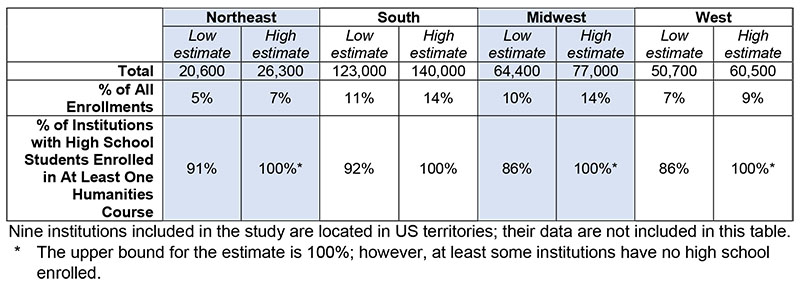
American Academy of Arts & Sciences, Humanities Indicators, "Humanities Education in Community Colleges: A Pilot Study" (https://humanitiesindicators.org/binaries/pdf/HI_Humanities_Education_in_Community_Colleges.pdf), March 2019.
Unduplicated Enrollments for High School Students in At Least One For-Credit, College-Level Humanities Course at Two-Year Colleges by Carnegie Classification, Fall 2015
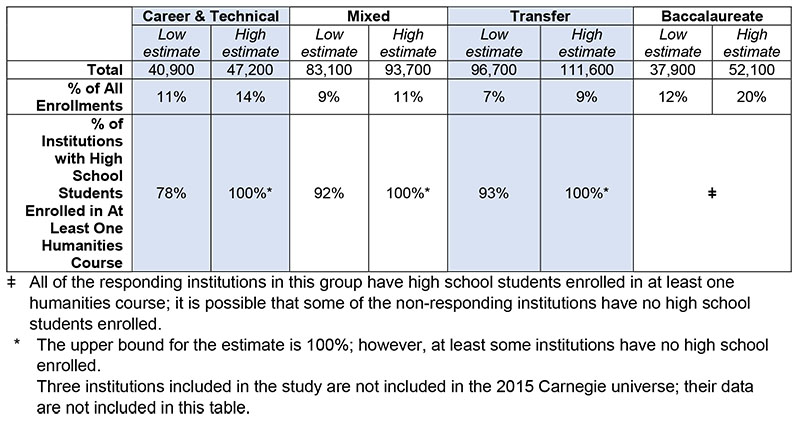
American Academy of Arts & Sciences, Humanities Indicators, "Humanities Education in Community Colleges: A Pilot Study" (https://humanitiesindicators.org/binaries/pdf/HI_Humanities_Education_in_Community_Colleges.pdf), March 2019.
Dually Enrolled High School Students Taking at Least One Humanities Course at a Community College, by Discipline, Fall 2015
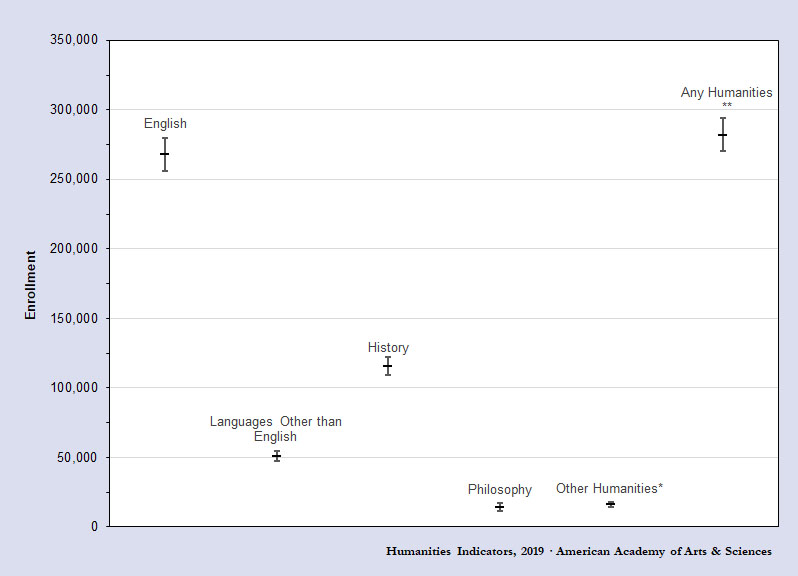
The middle bar depicts the estimated enrollment, and the upper and lower bars depict the range of uncertainty.
* Includes: 1) survey courses entitled “Humanities”; and 2) courses coded in colleges’ information systems as humanities but not counted in the other disciplinary categories.
** The estimated value for “Any Humanities Course” is unduplicated and thus less than the sum of the values for the individual disciplines.
For the values underlying this figure, see American Academy of Arts Sciences, Humanities Indicators, “Humanities Education in Community Colleges: A Pilot Study,” https://humanitiesindicators.org/binaries/pdf/HI_Humanities_Education_in_Community_Colleges.pdf (March 2019), appendix, tables 10, E5, FL5, H5, P5, and OH5.
* Includes: 1) survey courses entitled “Humanities”; and 2) courses coded in colleges’ information systems as humanities but not counted in the other disciplinary categories.
** The estimated value for “Any Humanities Course” is unduplicated and thus less than the sum of the values for the individual disciplines.
For the values underlying this figure, see American Academy of Arts Sciences, Humanities Indicators, “Humanities Education in Community Colleges: A Pilot Study,” https://humanitiesindicators.org/binaries/pdf/HI_Humanities_Education_in_Community_Colleges.pdf (March 2019), appendix, tables 10, E5, FL5, H5, P5, and OH5.
Share of Community Colleges with Dually Enrolled High School Students Taking Humanities Courses, by Discipline, Fall 2015
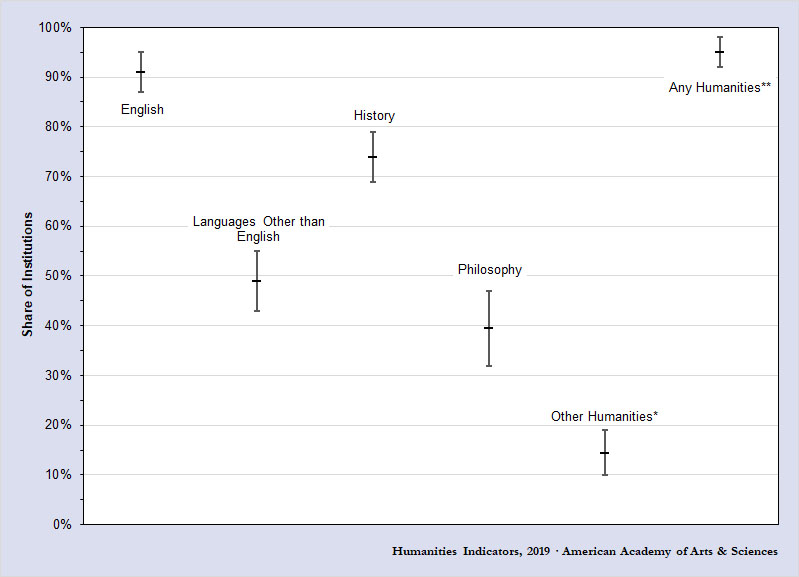
The middle bar depicts the estimated proportion, and the upper and lower bars depict the range of uncertainty.
* Includes: 1) survey courses entitled “Humanities”; and 2) courses coded in colleges’ information systems as humanities but not counted in the other disciplinary categories.
** The estimated value for “Any Humanities Course” is unduplicated and thus less than the sum of the values for the individual disciplines.
For the values underlying this figure, see American Academy of Arts Sciences, Humanities Indicators, “Humanities Education in Community Colleges: A Pilot Study,” https://humanitiesindicators.org/binaries/pdf/HI_Humanities_Education_in_Community_Colleges.pdf (March 2019), appendix, tables 5, E5, FL5, H5, P5, and OH5.
* Includes: 1) survey courses entitled “Humanities”; and 2) courses coded in colleges’ information systems as humanities but not counted in the other disciplinary categories.
** The estimated value for “Any Humanities Course” is unduplicated and thus less than the sum of the values for the individual disciplines.
For the values underlying this figure, see American Academy of Arts Sciences, Humanities Indicators, “Humanities Education in Community Colleges: A Pilot Study,” https://humanitiesindicators.org/binaries/pdf/HI_Humanities_Education_in_Community_Colleges.pdf (March 2019), appendix, tables 5, E5, FL5, H5, P5, and OH5.
Dually Enrolled High School Students as a Share of Community College Coursetakers in Selected Humanities Disciplines, by Region, Fall 2015
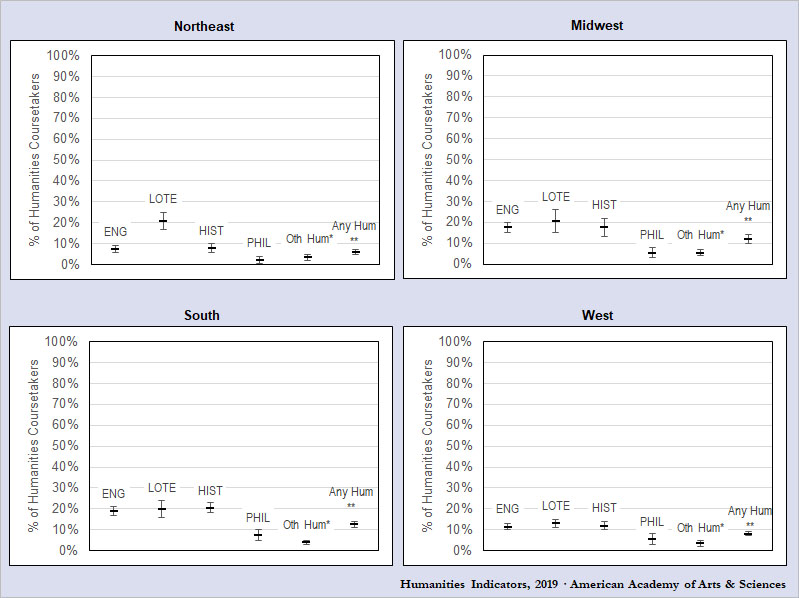
ENG: English • LOTE: Languages Other than English • HIST: History • PHIL: Philosophy
The middle bar depicts the estimated proportion, and the upper and lower bars depict the range of uncertainty.
* Oth Hum: Other humanities, includes: 1) survey courses entitled “Humanities”; and 2) courses coded in colleges’ information systems as humanities but not counted in the other disciplinary categories.
** Any Hum: Any humanities course
Nine institutions included in the study are located in US territories; their data were excluded from this analysis. For the values underlying this figure, see American Academy of Arts Sciences, Humanities Indicators, “Humanities Education in Community Colleges: A Pilot Study,” https://humanitiesindicators.org/binaries/pdf/HI_Humanities_Education_in_Community_Colleges.pdf (March 2019), appendix, tables 12, E7, FL7, H7, P7, and OH7.
The middle bar depicts the estimated proportion, and the upper and lower bars depict the range of uncertainty.
* Oth Hum: Other humanities, includes: 1) survey courses entitled “Humanities”; and 2) courses coded in colleges’ information systems as humanities but not counted in the other disciplinary categories.
** Any Hum: Any humanities course
Nine institutions included in the study are located in US territories; their data were excluded from this analysis. For the values underlying this figure, see American Academy of Arts Sciences, Humanities Indicators, “Humanities Education in Community Colleges: A Pilot Study,” https://humanitiesindicators.org/binaries/pdf/HI_Humanities_Education_in_Community_Colleges.pdf (March 2019), appendix, tables 12, E7, FL7, H7, P7, and OH7.

